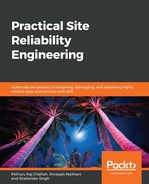The following are some challenges you may come across:
- Bringing forth a bevy of complexity mitigation techniques. The formula is heterogeneity + multiplicity = complexity. IT (software and infrastructure) complexity is constantly improving.
- Producing software packages that are fully compliant to various NFRs and QoS /QoE attributes, such as scalability, availability, stability, reliability, extensibility, accessibility, simplicity, performance/throughput, and so on.
- Performing automated IT infrastructure provisioning, scheduling, configuration, monitoring, measurement, management, and governance.
- Providing VM and container placement, serverless computing/Function as a Service (FaaS), workload consolidation, energy efficiency, task and job scheduling, resource allocation and usage optimization, service composition for multi-container applications, horizontal scalability, and Resource as a Service (RaaS).
- Establishing IT automation, Integration, and orchestration for self-service, autonomous, and cognitive IT.
- Accomplishing log, operational, and performance/scalability analytics using AI (machine and deep learning). Algorithms for producing real-time, predictive, and prescriptive insights.
- Building technology sponsored solutions for enabling NoOps, ChatOps, and AIOps. The challenge is to bring forth viable and versatile solutions in the form of automated tools for fulfilling their unique requirements.
- Container clustering, orchestration, and management platform solutions for producing, deploying, and sustaining microservices-centric software applications.
- Bringing forth versatile software solutions such as standards-compliant service mesh solutions, API gateways, and management suites for ensuring service resiliency. With more microservices and their instances across containers (service run time), the operational complexity is on the rise.
- Building resilient and reliable software through pioneering programming techniques such as reactive programming and architectural styles such as event-driven architecture (EDA).
The idea is to clearly illustrate the serious differences between agile programming, DevOps, and the SRE movement. There are several crucial challenges ahead, as we have mentioned. And the role and responsibility of the SRE technologies, tools, and tips are going to be strategic and significant toward making IT reliable, robust, and rewarding.
